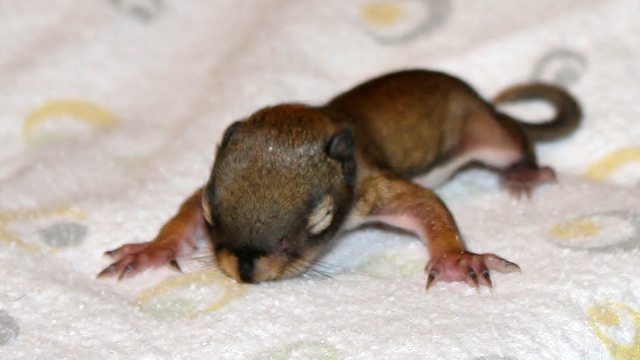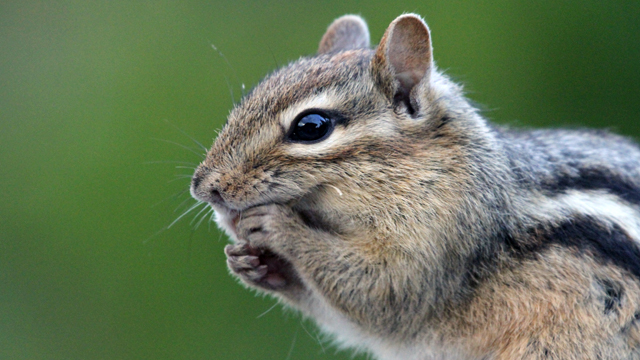What to do if an animal is already in your house
Animals in your attic
During the birthing season, we recommend giving the mother a temporary grace period to raise her young to the weaned stage so they are coming out with her. We need her to get them to that stage and it is the least risky solution from the homeowner’s perspective. Any action to either barricade the mother from the attic or to trap and relocate her can have serious consequences for you. Nests are generally in inaccessible spots near the eaves and if babies are orphaned and hungry, they will move around in search of the mother and can fall between walls, creating the need for expensive drywall removal to get to dead or dying animals.
After giving a grace period and babies have been noted coming and going with mom, you can start a feeding regime to encourage them to leave the attic sooner. For squirrels, you should use large striped sunflower seeds (not peanuts, as they will simply stash them) and place a pile on the ground in a strategic spot where the animals come and go from the roof, so they will be easily found. Put the seed out early in the morning and continue to put it out at the same time each day, but move the seed a little further away from the house so the animals are gradually being lured away. After about six days and when you see that mom and all her babies are out eating the seed, then you can animal proof as above. After the proofing has been completed, make sure to stay around the house for the rest of the day and the following day to listen in case one is trapped inside. If that happens the site will need to be re-opened to let it out.
For raccoons, once the babies are old enough to travel with mom, she will begin to take them out around dusk, so at this time you can start a feeding regime. Use dry cat kibble, and set it out in a bowl at dusk and then follow the same method used for squirrels. Once you are confident that the whole family is out, the proofing can be done.
Because the raccoons only go out after dusk, you might have to encourage them to want to leave by opening the attic hatch a few times during the day and shining a light in their direction, along with making some noise. You might have to consider a temporary repair if it has to be done after dark, leaving the full repair for daylight, but only after you are certain they are no longer in the attic.
Animal under my steps
The best thing to do is prevention (see below). But this must be done at the right time to ensure that you are not trapping anyone inside. If that happens, and there are babies, they would die under there creating a bad smell that would linger for a long time. In desperation, an adult might find a way to dig them out, and in doing so, could figure out how to dig around the proofing you’re going to install. Babies are born from late winter to the end of June. Newborns have their eyes closed and are not mobile until they are around 8 weeks old, so mark on your calendar 8 weeks from the time you first noticed activity. After the 8 weeks have passed place a ball of paper towel in the hole. If the paper towel is pushed out, the animals are still living there. Since the babies are mobile it is now safe to try some deterrents (you do not want to use the deterrents too early in the birthing season as you do not want to scare mom away leaving her babies in the burrow as they would not survive without her). The deterrents include:
- dog hair - If you don’t have a dog, try a pet store or grooming studio. Place the dog hair in a nylon stocking or onion bag and attach the bag to a small stick and place it near the burrow. This indicates the presence of a predator.
- a battery operated radio - make sure it is battery operated for fire safety. This works best if it is on a talk station during the daytime for skunks, and during the evening for groundhogs.
- human clothing - place some strongly scented human clothing (ie. worn socks, gym clothes) around the burrow, this will also indicate a predator is near.
After the deterrents have been used for approximately 5 days, try the paper towel trick again. If the paper is not moved for 3 full days, you can assume the animal(s) have moved on and you can animal-proof. The first step is to dig a trench around the base of the steps on all sides the animal could dig. The trench should be 1 foot deep and 1 foot wide and the material you will use is 1" x 1" welded wire mesh (16-19 gauge) which is available at most hardware stores. Do not use chicken wire as it is too weak. Secure the welded wire mesh to the bottom of the structure and run the mesh straight down into the trench and then bend the mesh at a right angle, away from the structure, to cover the bottom of the trench.
Animal in a window well
First: Do not try to smoke it out!
If a raccoon has moved in during the spring it is almost certainly having babies. At this point, do nothing. Trying to chase or scare them away will likely result in mom leaving some or all the babies behind. This may mean removing dead and smelly carcasses. There is limited space in a chimney and as the babies grow, this normally forces mom to move on with the babies. There is little harm they can cause to a chimney, just be sure the damper is securely closed. When you think they have moved out (usually about 8 weeks after you first hear noises), place a bunched up ball of paper towel in the top of the chimney. If it isn’t moved after 2 full days and nights, and no noise is heard a spark arrestor screen made from 1"x1" welded wire mesh should be installed. If the paper is moved, something is still coming and going. So wait a week and try again. It is vital to monitor closely before having the animal proofing done. Raccoons can have young even into mid August, so to be safe you should use the previous steps between early March and the end of September.
Sometimes an animal can get stuck in the chimney (usually birds or squirrels). There are two options to get them out:
- For squirrels, access the chimney from the roof and hang a thick rope inside. Leave it, and the squirrel will climb out.
This option will work for squirrels or birds. Choose a door or window that is closest to the fireplace, if the window is raised more than a foot from the floor, use some boxes as a step up to it. Darken the room so that the animal will be attracted to the light and the smell of fresh air coming from the window or door. Make a path to the door or window using cardboard boxes or the coffee table on its side, or blankets suspended from the ceiling - anything to funnel the squirrel or bird towards the window. Close off other doors. Once the path is in place, and you have the door or window open then gently open the damper to allow the creature access to the hearth. Leave the room, make sure any pets are not around, and be sure there is no noise at all – you don’t want to scare it into staying in the chimney or coming out and finding a place to hide in your house. It may take a half hour or more for the critter to feel safe enough to come down. It is important to do this during daylight.





